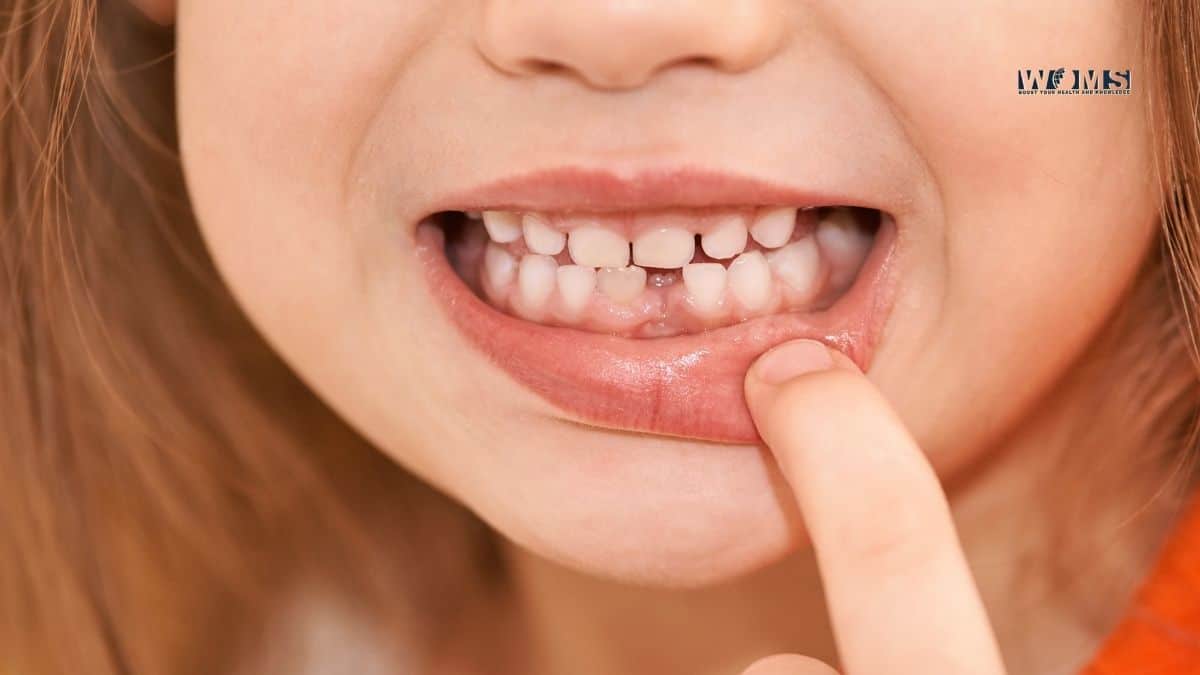Teeth Gap: Is it good or bad?

A space or gap between the teeth is also known as a diastema or teeth gap. This gap can be present anywhere between the teeth. But, it is more prominent among the upper front teeth.
Teeth gaps can be present in both children and adults. As the child grows, the tooth gap disappears because of permanent teeth.
Some people have small tooth gaps and are not noticeable. Many people find it cosmetically attractive. Moreover, many people have larger teeth gaps and need corrective options.
Many dentists don’t suggest any treatment for these tooth gaps. But, if you dislike it, there are several ways to close or reduce the tooth gap.
Causes of teeth gap:
There is not only a single cause for teeth gap. Several possible factors contribute to developing it. Moreover, this condition may be related to the tooth size or jaw size of the person.
In this way, there are multiple reasons for tooth gaps. Let’s review all these causes of tooth gaps.
Labial frenum attachment:
The most common cause of it is the abnormal attachment of the labial frenum. A frenum is the fold of skin inside the upper lip.
You can easily feel it. If the frenum attachment is lower than normal, it may cause a tooth gap. In most instances, frenum attachment is on the gums so down that it keeps the teeth apart.
Habits:
Certain habits in children like thumb sucking can also develop it. Thumb sucking puts pressure on the back of the teeth.
This pressure pushes the teeth in the forward direction. In this way, these habits can cause tooth gaps in children.
Size of teeth in comparison to jaw bone:
Some people have larger jaws in comparison with the teeth size. Therefore, teeth tend to have spaces between them to adjust on the jaw.
Jaw bone and tooth size depend on genetics. Therefore, teeth gap or diastema runs in families.
Missing or smaller teeth:
Some people may not have a complete set of teeth. There may be some missing teeth in the dentition.
Moreover, there may be smaller teeth. Both these conditions can cause tooth gaps. Missing teeth leave space and cause teeth gaps.
Tongue thrusting:
Tongue thrusting is abnormal swallowing reflux. In this condition, the tongue positions itself at the roof of the mouth during swallowing.
In this way, the tongue puts pressure against the front teeth. This pressure leads to a separation between the teeth which is a teeth gap.
Gum diseases:
Gum infection results in damage to the bone and supporting structures of teeth.
In addition, gum diseases can also cause tooth migration. These gum infections can lead to tooth loss and a gap between the teeth.
Primary teeth loss:
Children develop temporary teeth gaps when they lose their baby teeth. When permanent teeth erupt, these gaps between teeth disappear.
This pattern is a normal developmental phenomenon. If baby teeth are lost before time because of any reason, dentists recommend retainers between the teeth. These retainers help to protect space for the permanent tooth.
Problems arising from teeth gap:
There may be some issues occurring due to teeth gaps. Some of them are as follows:
- Crooked or crowded teeth – a larger gap between teeth may induce crowding in the other teeth
- Self-satisfaction – some people may become conscious due to a gap between the teeth
How to prevent it?
Some forms of teeth gap are genetic. Whereas, the other may be due to some habits or dental disturbances. Therefore, it is not possible to prevent all types of tooth gaps.
Genetic forms are hereditary so can’t be prevented. There are some ways to prevent teeth gaps. These are as follows:
- Brushing teeth twice daily to prevent any gum disease
- Visit your dentist regularly for proper examination of teeth
- Avoid thumb sucking like habits to prevent spaces between your teeth.
- Correct your swallowing reflexes with the help of a dentist to prevent teeth gaps.
The treatment plan for teeth gap:
Treatment is not usually necessary for the teeth gap if the cause is genetic. Dentists don’t suggest any treatment if there is any discrepancy between the jaw bone size and teeth size.
If a person wants treatment for his teeth gap, your dentist will surely help to provide you with a better treatment option. There are several treatment options for teeth gaps. Some of them are as follows:
Braces:
Dentists usually treat teeth gaps with braces. Braces put pressure on the teeth to come close. In this way, the teeth gap closes over time.
It is necessary to wear a full set of braces for some time even for a single tooth gap. Because teeth movement affects the whole mouth.
Dental bridges or implants:
Dentists recommend dental bridges or implants if the teeth gap is due to any missing teeth. Dental implants are quite an extensive dental procedure by inserting mental screws into the jaw bone.
Dental bridges are false teeth placed by an appliance attached to both teeth on either side of the gap.
Veneers or bonding:
This treatment is suitable if your teeth gap is due to smaller teeth. Dentists recommend veneer and dental bonding instead of braces.
Veneers are thin, customized pieces of porcelain attached to the surfaces of teeth. Dental bonding includes resin application to the surfaces of the teeth followed by hardening with the light source.
Surgery:
If the tooth gap is due to an abnormally placed labial frenum, dentists usually recommend frenectomy. This procedure includes the removal of extra tissue and normal positioning.
After surgery, children or older patients may require braces or any other treatment to close the gap. In younger patients, the tooth gap closes on its own.
Gum disease treatment:
Your dentist will suggest some treatment to stop gum infection. Once gum infection heals, the chances of tooth loss and tooth gap reduce.
Also read: How to get sharper jawline through Jawline Exercises?
Conclusion:
The teeth gap or diastema is the space between the teeth. There are several factors that can cause tooth gaps. Some people don’t bother about it.
Whereas, many of them also want the correction of these teeth gaps for aesthetic purposes. Your dentist can determine the real cause of the tooth gap.
There are several treatment options to reduce or close teeth gaps. Your dentist will suggest you according to the situation. The results of these treatments are usually permanent.
Frequently asked questions(FAQs):
How can we diagnose teeth gaps?
Simply, you may feel space between your teeth. Moreover, your dentist can also spot teeth gaps during any regular dental examination. In addition, you can also feel more gaps between teeth while brushing or flossing.
Can teeth gaps reduce or close by themselves?
In children, it is common to have a gap between front teeth. By the time teeth erupt, this gap closes by itself.
In adults, gaps between teeth close themselves as more permanent teeth erupt. But some people may have persistent teeth gaps.
What is the best age for the treatment of teeth gaps?
Parents should consult their dentist if their children have a tooth gap. The American Association of Orthodontists suggests evaluating all children at the age of seven. Your dentist can diagnose the underlying cause in a better way. After this, he will suggest a treatment plan according to the cause.




